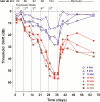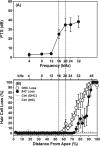Prolonged noise exposure-induced auditory threshold shifts in rats
- PMID: 25219503
- PMCID: PMC4252814
- DOI: 10.1016/j.heares.2014.08.004
Prolonged noise exposure-induced auditory threshold shifts in rats
Abstract
Noise-induced hearing loss (NIHL) initially increases with exposure duration, but eventually reaches an asymptotic threshold shift (ATS) once the exposure duration exceeds 18-24 h. Equations for predicting the ATS have been developed for several species, but not for rats, even though this species is extensively used in noise exposure research. To fill this void, we exposed rats to narrowband noise (NBN, 16-20 kHz) for 5 weeks starting at 80 dB SPL in the first week and then increasing the level by 6 dB per week to a final level of 104 dB SPL. Auditory brainstem responses (ABR) were recorded before, during, and following the exposure to determine the amount of hearing loss. The noise induced threshold shift to continuous long-term exposure, defined as compound threshold shift (CTS), within and above 16-20 kHz increased with noise level at the rate of 1.82 dB threshold shift per dB of noise level (NL) above a critical level (C) of 77.2 dB SPL i.e. CTS = 1.82(NL-77.2). The normalized amplitude of the largest ABR peak measured at 100 dB SPL decreased at the rate of 3.1% per dB of NL above the critical level of 76.9 dB SPL, i.e., %ABR Reduction = 3.1%(NL-76.9). ABR thresholds measured >30 days post-exposure only partially recovered resulting in a permanent threshold shift of 30-40 dB along with severe hair cell loss in the basal, high-frequency region of the cochlea. In the rat, CTS increases with noise level with a slope similar to humans and chinchillas. The critical level (C) in the rat is similar to that of humans, but higher than that of chinchillas.
Copyright © 2014 Elsevier B.V. All rights reserved.
Figures








References
-
- Atherley GR, Hempstock TI, Noble WG. Study of tinnitus induced temporarily by noise. J Acoust Soc Am. 1968;44:1503–1506. - PubMed
-
- Axelsson A, Hamernik RP. Acute acoustic trauma. Acta oto-laryngologica. 1987;104:225–233. - PubMed
-
- Axelsson A, Sandh A. Tinnitus in noise-induced hearing loss. British journal of audiology. 1985;19:271–276. - PubMed
-
- Blakeslee EA, Hynson K, Hamernik RP, Henderson D. Asymptotic threshold shift in chinchillas exposed to impulse noise. J Acoust Soc Am. 1978;63:876–882. - PubMed
Publication types
MeSH terms
Grants and funding
LinkOut - more resources
Full Text Sources
Other Literature Sources
Research Materials
Miscellaneous

